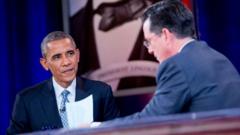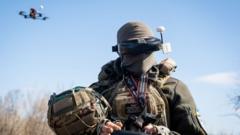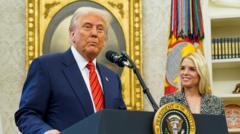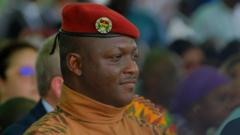Ukrainian soldiers reflect on their disorganized withdrawal from Russia's Kursk region, revealing the difficulties of communication and logistics. Amidst rumblings of international negotiations, they express frustration over foreign leaders discussing the war without addressing the realities on the ground.
Chaos and Reflection: Ukrainian Soldiers Discuss Their Retreat from Russian Territory
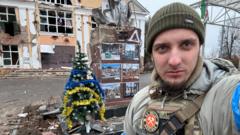
Chaos and Reflection: Ukrainian Soldiers Discuss Their Retreat from Russian Territory
As Ukraine withdraws from the Kursk region, soldiers share insights on the challenges faced during their chaotic retreat, and contrasting diplomatic efforts abroad.
Article Text:
Until just over a week ago, Artem Kariakin and his combat unit frequently crossed into Russian territory, particularly the town of Sudzha. As they retreated from Russia's Kursk region, Artem shared a video from their final excursion—a chaotic scene marked by the remnants of scorched military and civilian vehicles. During the retreat, a soldier armed with a shotgun kept watch for Russian drones. Suddenly, one approached and detonated near their transport; luckily, the explosion wasn't powerful enough to incapacitate them, though another truck nearby was engulfed in flames.
Reflecting on the disorganized nature of the retreat from Sudzha, the largest town held by Ukraine within Kursk, Artem described it as "not well organized." He pointed out that many units were left in disarray, attributing the chaos to a delayed withdrawal order and insufficient communication tools since crucial Starlink satellite systems malfunctioned in Russian territory.
Despite the setback, the 27-year-old soldier views the overall Kursk offensive favorably, noting it successfully compelled Russia to divert their forces from the eastern front. Although most troops managed to escape, many had to do so on foot. Artem believes the initial incursion in August was overly ambitious, straining supply lines along a singular main road.
While Artem and his unit retreated, significant global players such as US President Donald Trump and Russian President Vladimir Putin were engaged in conversations aimed at concluding the conflict. Artem found this surreal, expressing disbelief that the two leaders could negotiate seriously about a war affecting his homeland. Disillusioned by perceived indifference from US leadership towards Ukrainian sovereignty, Artem voiced disappointment about attempts to negotiate territorial concessions.
Meanwhile, Ukrainian cross-border operations continue into Russian territory, including Belgorod. The narrative shifts to Serhiy's assault battalion, which actively plans these incursions—navigating dangers like minefields and anti-tank obstacles. On a night mission, Serhiy, born in Russia but fighting for Ukraine, underscores the necessity of their actions in light of Russia trying to establish a buffer zone deep within Ukrainian land.
Throughout their excursion near the border, Serhiy remained acutely aware of threats, listing glide bombs and drones among potential risks. Despite possessing vehicles with electronic countermeasures, he acknowledged the challenges of advanced enemy technologies. Their mission, initially focused on recovering US-made Bradley vehicles, encountered complications when intel indicated Russian drone activity nearby. Ultimately locating a broken-down Bradley vehicle, Serhiy's adept handling showcases the complexities of modern warfare.
The reliance on US military support looms large, especially as uncertainty hangs in the wake of Trump's diplomatic maneuvers. Serhiy fears that the absence of American assistance could lead to detrimental peace terms for Ukraine. He observed that European powers lack the strength necessary to address the conflict effectively, diverting their focus instead to domestic economic concerns.
The call for an end to war resonates with both soldiers. However, similarly to their colleagues, Serhiy and Artem, express a desire for peace on terms favorable for Ukraine, not just any settlement. The grim realities of their experiences underscore the challenges of navigating the confluence of battlefield strategies and global diplomacy.
Until just over a week ago, Artem Kariakin and his combat unit frequently crossed into Russian territory, particularly the town of Sudzha. As they retreated from Russia's Kursk region, Artem shared a video from their final excursion—a chaotic scene marked by the remnants of scorched military and civilian vehicles. During the retreat, a soldier armed with a shotgun kept watch for Russian drones. Suddenly, one approached and detonated near their transport; luckily, the explosion wasn't powerful enough to incapacitate them, though another truck nearby was engulfed in flames.
Reflecting on the disorganized nature of the retreat from Sudzha, the largest town held by Ukraine within Kursk, Artem described it as "not well organized." He pointed out that many units were left in disarray, attributing the chaos to a delayed withdrawal order and insufficient communication tools since crucial Starlink satellite systems malfunctioned in Russian territory.
Despite the setback, the 27-year-old soldier views the overall Kursk offensive favorably, noting it successfully compelled Russia to divert their forces from the eastern front. Although most troops managed to escape, many had to do so on foot. Artem believes the initial incursion in August was overly ambitious, straining supply lines along a singular main road.
While Artem and his unit retreated, significant global players such as US President Donald Trump and Russian President Vladimir Putin were engaged in conversations aimed at concluding the conflict. Artem found this surreal, expressing disbelief that the two leaders could negotiate seriously about a war affecting his homeland. Disillusioned by perceived indifference from US leadership towards Ukrainian sovereignty, Artem voiced disappointment about attempts to negotiate territorial concessions.
Meanwhile, Ukrainian cross-border operations continue into Russian territory, including Belgorod. The narrative shifts to Serhiy's assault battalion, which actively plans these incursions—navigating dangers like minefields and anti-tank obstacles. On a night mission, Serhiy, born in Russia but fighting for Ukraine, underscores the necessity of their actions in light of Russia trying to establish a buffer zone deep within Ukrainian land.
Throughout their excursion near the border, Serhiy remained acutely aware of threats, listing glide bombs and drones among potential risks. Despite possessing vehicles with electronic countermeasures, he acknowledged the challenges of advanced enemy technologies. Their mission, initially focused on recovering US-made Bradley vehicles, encountered complications when intel indicated Russian drone activity nearby. Ultimately locating a broken-down Bradley vehicle, Serhiy's adept handling showcases the complexities of modern warfare.
The reliance on US military support looms large, especially as uncertainty hangs in the wake of Trump's diplomatic maneuvers. Serhiy fears that the absence of American assistance could lead to detrimental peace terms for Ukraine. He observed that European powers lack the strength necessary to address the conflict effectively, diverting their focus instead to domestic economic concerns.
The call for an end to war resonates with both soldiers. However, similarly to their colleagues, Serhiy and Artem, express a desire for peace on terms favorable for Ukraine, not just any settlement. The grim realities of their experiences underscore the challenges of navigating the confluence of battlefield strategies and global diplomacy.

